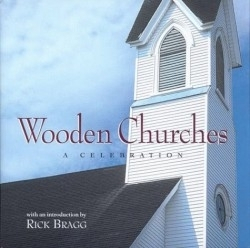Wooden Churches
A Celebration
“It will have a cross on it somewhere, and then there can be no doubt, no discussion, that this is and always will be the House of the Living God.
Say Amen, somebody.” So writes Rick Bragg in his introduction to Wooden Churches. This tabletop book uses a mixed bag of images and words to usher in a sense that religion’s impact on every day life is as profound as a proud, white steeple cutting through a sapphire sky.
Photographs fill each page. They show both the simple and elaborate designs dedicated to places of worship of primarily Christian faiths
around the nation. There is the powerful elegance of the lone church standing among only the fields and clouds, creating its own community where there is none other in Colfax County, Nebraska. There is the sadness emitted by the neglected church where the paint already has fallen away and the walls are propped against wooden beams to fend off gravity’s decay for at least awhile longer in Louisiana.
Wooden Churches often takes readers back in time, through time periods including the Civil War era, the Great Depression and the Roaring Twenties. One page shows General U.S. Grant sitting in a pew, bent over his papers, plotting strategy in 1864. In another, a boy sits with his head bowed in front of Sudley Church after the First Battle of Bull Run in 1861. The many faces of the faithful shine through in the collection of photographs: large, small, black, white, lively, subdued, the pure awaiting their baptism, the devilish dressed in leopard skin as their Sunday best.
The images set the mood for literary quotations that complete the book. They come in the form of biblical verses, essays by the nation’s forefathers such as Thomas Jefferson and the thoughts of some of fiction’s greatest characters such as John Wheelwright from John Irving’s A Prayer for Owen Meany and several Mark Twain classics. Their words convey every facet of faith. They glorify it and doubt it. They portray the church as just a part of every day life through their stories of gum chewing, bible studies, even napping hogs.
One passage is from Huckleberry Finn: “There warn’t anybody at the church, except maybe a hog or two, for there warn’t any lock on the door, and hogs like a puncheon floor in the summertime because it’s cool. If you notice, most folks don’t go to church only when they’ve got to; but a hog is different.”
Wooden Churches can be enjoyed one page at a time, with no regard as to what comes before it or after it. The delicately designed book supplies many moments of humor, reflection and artistic enjoyment.
Reviewed by
Marjory Raymer
Disclosure: This article is not an endorsement, but a review. The publisher of this book provided free copies of the book to have their book reviewed by a professional reviewer. No fee was paid by the publisher for this review. Foreword Reviews only recommends books that we love. Foreword Magazine, Inc. is disclosing this in accordance with the Federal Trade Commission’s 16 CFR, Part 255.

